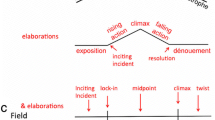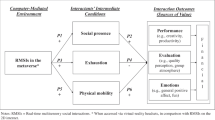Abstract
In the last decades, advances in interactive information technologies have facilitated collaborative fiction writing, which has become widespread and large-scale. This paper proposes a framework to analyze collaborative storytelling systems, made of a set of parameters divided into six conceptual areas. Four of them relate to the systems and two (process and output) to the results of the collaboration. Through this framework we can study more precisely these different factors of the systems, their interplay, and how they impact the creators’ performance. We also present a controlled extended-duration field study on collaborative storytelling, and we use this framework to comparatively analyze these observations and other relevant experiences in the field of co-creation of shared narrative spaces. As a result, we propose a human-information interaction model for collaborative narrative systems, intended to better support co-creation and address the barriers of this kind of systems turning them into new opportunities for collaboration.







Similar content being viewed by others
References
Ajanki, Antti; Markus Koskela; Jorma Laaksonen; and Samuel Kaski (2013). Adaptive timeline interface to personal history data. In Proceedings of the 15th ACM on International conference on multimodal interaction, Sydney, Australia, 9–13 December 2013. New York: ACM Press, pp. 229–236.
Bannon, Liam; and Sussane Bødker (1997). Constructing common information spaces. In ECSCW 1997: Proceedings of the Fifth European Conference on Computer Supported Cooperative Work, Lancaster, United Kingdom, 7–11 September 1997, Springer Netherlands, pp. 81–96.
Batrinca, Ligia; Muhammad T. Khan; Dorrit Billman; Basak Aydemir; and Gregorio Convertino (2013). A Timeline Visualization for Multi-team Collaborative Planning. In CHI ’13: Extended Abstracts on Human Factors in Computing Systems, April 2013. New York: ACM Press, pp. 157–162.
Bernstein, Mark (2001). Card shark and thespis: exotic tools for hypertext narrative. In Proceedings of the 12th ACM conference on Hypertext and Hypermedia, Arhus, Denmark, 14–18 August 2001. New York: ACM Press, pp. 41–50.
Chatman, Seymour Benjamin (1980). Story and discourse: Narrative structure in fiction and film. Ithaca: Cornell University Press.
Colás, Joaquim; Alan Tapscott; Ayman Moghnieh; and Josep Blat (2013). Shared narratives as a new interactive medium: Crosstale as a prototype for collaborative storytelling. In International Journal on Advances in Telecommunications, vol. 6, nos. 1 & 2, pp. 12–23.
Colás, Joaquim; Alan Tapscott; Ayman Moghnieh; and Josep Blat (2015). An interaction model based on Narrative Programs to improve understanding and contribution to non-linear narratives. In MMEDIA 2015, Barcelona, Spain, 19-24 April 2015, IARIA, pp. 62–67.
Colás, Joaquim; Alan Tapscott; Valeria Righi; Ayman Moghnieh; and Josep Blat (2016). Yoway: Coupling Narrative Structure with Physical Exploration in Multi-Linear Locative Narratives. In Games and Virtual Worlds for Serious Applications (VS-Games), 2016 8th International Conference on, Barcelona, Spain, 7–9 September 2016, IEEE, pp. 1–7.
Greimas, Algirdas J. (1983). Structural semantics: An attempt at a method. Lincoln: University of Nebraska Press.
Koenitz, Hartmut; Mads Haahr; Gabriele Ferri; Tonguc Sezen; and Digdem Sezen (2013). Mapping the Evolving Space of Interactive Digital Narrative - From Artifacts to Categorizations. In Proceedings of the 6th International Conference on Interactive Storytelling, Istambul, Turkey, 6–9 November 2013, Springer-Verlag New York, Inc., pp. 55–60.
Lay, Mary M.; and William M. Karis (eds) (1991). Collaborative writing in industry: Investigations in theory and practice. Baywood Publishing Company.
Likarish, Peter; and Jon Winet (2012). Exquisite Corpse 2.0: qualitative analysis of a community-based fiction project. In Proceedings of the Designing Interactive Systems Conference, Newcastle Upon Tyne, United Kingdom, 11–15 June 2012. New York: ACM Press, pp. 564–567.
Lowry, Paul Benjamin; Aaron Curtis; Michelle René Lowry (2004). Building a taxonomy and nomenclature of collaborative writing to improve interdisciplinary research and practice. Journal of Business Communication, vol. 41, no. 1, SAGE, pp. 66–99.
Luther, Kurt; Casey Fiesler; and Amy Bruckman (2013). Redistributing leadership in online creative collaboration. In CSCW 2013: Proceedings of the 2013 conference on Computer Supported Cooperative Work, San Antonio, Texas, USA, 17–23 February 2013. New York: ACM Press, pp. 1007–1022.
Magerko, Brian (2014). The PC3 Framework: A Formal Lens for Analyzing Interactive Narratives across Media Forms. In International Conference on Interactive Digital Storytelling ICIDS 2014, Singapore, Singapore, 3–6 November 2014, Springer International Publishing, pp. 103–112.
Marshall, Mark T.; Daniella Petrelli; Nick Dulake; Elena Not; Michele Marchesoni; Elisa Trenti; and Anna Pisetti (2016). Audio-based narratives for the trenches of World War I: Intertwining stories, places and interaction for an evocative experience. International Journal of Human-Computer Studies, vol. 85, pp. 27–39.
Martin, George R. R. (2012). Wild Cards. London: Gollancz Print.
Mason, Bruce; and Sue Thomas (2008). A million penguins research report. De Montfort University, Leicester, United Kingdom: Institute of Creative Technologies.
Neuwirth, Christine M.; David S. Kaufer; Ravinder Chandhok; and James H. Morris (1994). Computer support for distributed collaborative writing: defining parameters of interaction. In CSCW 1994: Proceedings of the ACM conference on Computer supported cooperative work, Chapel Hill, North Carolina, USA, 22–26 October 1994. New York: ACM Press, pp. 145–152.
Newby, Gregory (1997). Metric multidimensional information space. In NIST special publication, no. 500238, NIST, pp. 521–536.
Ostergaard, Karen J.; and Joshua D. Summers (2003). A taxonomic classification of collaborative design. In DS 31: Proceedings of ICED 03, the 14th International Conference on Engineering Design, Stockholm, Sweden, 19–21 August 2003, The Design Society, pp. 617–618 (exec. summ).
Pope, James (2006). A Future for Hypertext Fiction. In Convergence: The International Journal of Research into New Media Technologies, vol. 12, no. 4, pp. 447–465.
Posner, Ilona. R.; and Ronald M. Baecker (1992). How People Write Together. In Proceedings of the Twenty-Fifth Annual Hawaii International Conference on System Sciences, Kauai, HI, USA, 7–10 January 1992, IEEE, pp. 127–138.
Propp, Vladimir (1968). Morphology of the Folktale. Austin: University of Texas Press.
Salen, Katie; and Eric Zimmerman (2004). Rules of play: Game design fundamentals. Cambridge, Mass.: MIT Press.
Spierling, Ulrike; Sebastian A. Weiß; Wolfgang Müller (2006). Towards accessible authoring tools for interactive storytelling. In International Conference on Technologies for Interactive Digital Storytelling and Entertainment, Darmstadt, Germany, 4–6 December 2006, Springer Berlin Heidelberg, pp. 169–180.
Sun, Yunting; Diane Lambert; Makoto Uchida; and Nicolas Remy (2014). Collaboration in the cloud at Google. In Proceedings of the 2014 ACM conference on Web science, Bloomington, Indiana, USA, 23-16 June 2014. New York: ACM Press, pp. 239–240.
Szilas, Nicolas; and Ioana Ilea (2014). Objective metrics for interactive narrative. In International Conference on Interactive Digital Storytelling, ICIDS 2014, Singapore, Singapore, 3–6 November 2014, Springer International Publishing, pp. 91–102.
Tapscott, Alan; Joaquim Colás; Ayman Moghnieh; and Josep Blat (2013). Writing Consistent Stories based on Structured Multi-Authored Narrative Spaces. In OASIcs-OpenAccess Series in Informatics, vol. 32, Schloss Dagstuhl-Leibniz-Zentrum fuer Informatik, pp. 277–292.
Tapscott, Alan; Joaquim Colás; Ayman Moghnieh; and Josep Blat (2014). Modifying Entity Relationship Models for Collaborative Fiction Planning and its Impact on Potential Authors. In OASIcs-OpenAccess Series in Informatics, vol. 41, Schloss Dagstuhl-Leibniz-Zentrum fuer Informatik, pp. 209–221.
Tapscott, Alan; Joaquim Colás; Valeria Righi; Carlos León; and Josep Blat (2016). We Built Our Own Worlds - Story Canonicity and Indirect Collaboration in a Shared Story World. In Proceedings of the Sixth International Conference on Advanced Collaborative Networks, Systems and Applications (COLLA 2016), Barcelona, Spain, 13–17 November 2016, IARIA, pp. 30–38.
Tapscott, Alan. (2017). Cross-Referencing, Collaboration and Canonicity in an Open Story World - The SCP Foundation. Article in preparation.
Wang, Dakuo; Judith S. Olson; Jingwen Zhang; Trung Nguyen; and Gary M. Olson (2015). DocuViz: visualizing collaborative writing. In CHI 2015: Proceedings of the 33rd Annual ACM Conference on Human Factors in Computing Systems, Seoul, Republic of Korea, 18–23 April 2015. New York: ACM Press, pp. 1856–1874.
Author information
Authors and Affiliations
Corresponding author
Rights and permissions
About this article
Cite this article
Colás, J., Tapscott, A., Righi, V. et al. Interaction and Outcomes in Collaborative Storytelling Systems: a Framework, a Field Study, and a Model. Comput Supported Coop Work 26, 627–662 (2017). https://doi.org/10.1007/s10606-017-9290-0
Published:
Issue Date:
DOI: https://doi.org/10.1007/s10606-017-9290-0




